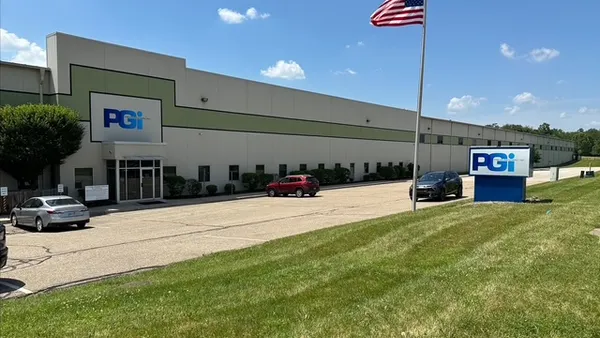While a shortage of truck drivers has made headlines since 2005, a broader labor shortage has crept into a variety of other industrial verticals as well. This talent gap has slowly and continuously widened over the past several decades as many U.S. companies moved their manufacturing assets overseas to access cheaper labor.
Now, established and reshoring industrial operators struggle to recruit and retain laborers. About 62% of manufacturers and distributors named hiring skilled talent as a top labor challenge, according to a joint survey of manufacturers, distributors, retailers, 3PLs and other industrial businesses by West Monroe and Supply Chain Dive's studioID.
Not Just a COVID-19 Problem
While 24% of survey respondents named COVID-19 unemployment relief as a hiring challenge, the fact remains that a talent crisis has been spreading across U.S. factories and warehouses for some time. It was there before the COVID-19 pandemic and will continue to challenge business leaders in a post-pandemic world.
"Labor issues are compounding," said Jeremy Tancredi, partner, at West Monroe. "There's not as many people going into manufacturing and distribution as there were in the past. The workforce now is looking for jobs with more flexibility and better work/life balance. Unfortunately, a lot of the jobs in this sector require shift work and forced overtime to meet production plans. While it used to be a more lucrative job, now there isn't as much of a pay differential compared with some less physical, less manual, less inflexible jobs out there. It will continue to be a big challenge trying to get people to sign up for this kind of work."
When a business doesn't have enough employees, the strain on the remaining workforce negatively affects retention. The struggle to attract workers has resulted in understaffing at 45% of the businesses that responded to the survey, while 34% reported problems with high turnover.
"First and foremost, businesses with staffing problems need to implement better labor planning," Tancredi said. "When you base production or fulfillment on historical averages and assume you can always get that same throughput, then you don't have a real understanding of what your optimum production capabilities are. One of the best ways to address this is to look at your production cycle or distribution cycle and determine your actual labor needs. If you take a general lean approach to operations to ensure you've eliminated all the excess, then you can get the highest level of productivity out of the workers you have."
Augmenting the Existing Workforce
A committed and productive labor force is key to any industrial operation, as recognized by the 95% of survey respondents who said that labor-management is very important or somewhat important to their production and supply planning. Despite this recognition, 75% of respondents still use Microsoft Excel as a primary sales and operations planning tool. Heavy reliance on manually controlled processes can make it difficult to optimize the productivity of a limited labor force.
"A lot of companies in these industries are still using paper or spreadsheets to track and plan labor and production," Tancredi said. "They need to get off these paper-based systems. We're not talking full automation here; we're just looking for tools such as LMS or RF solutions to enable better tracking of what's going on in the operation. It comes down to having that real-time visibility in your factory or warehouse that is enabled by these technologies. You need to be able to understand how you're tracking to a plan. Once you have those core processes together, you can start looking at how to supplement the workforce with efficient technologies, like automated conveyor belts or sortation systems."
Facility managers can establish accurate productivity standards with better labor management in place. These standards give each employee a reasonable target to hit while allowing enough time for necessary breaks.
"You can't just assume people will come in and do what they need to do and go home,” Tancredi said. "Ask someone to do 100 cases per hour and give them eight hours to do it, many people will stop at 100 cases per hour even if they could do more. People will adapt the time to the work they get assigned, which is why it's crucial to ensure your baseline is accurate and optimized."
Many industrial businesses hire temporary workers to accommodate increased demand during the holiday peak season or other expected demand spikes. Improved labor management can be especially useful in peak demand periods when less-experienced workers on the floor may not know how to spend their time optimally.
"When you're short-staffed, you bring more temporary workers into the facility," Tancredi added. "Expectations are typically low for temp workers. With proper labor management solutions in place, they still might not be as effective as full-time employees, but you can manage them within set standards and expectations."
Short-staffed companies are filling gaps by temporarily shifting corporate employees to serve in critical assembly or service roles while they aggressively seek to hire and train new employees. Companies should continue to implement creative and flexible options to support their employees. Warehouses and factories can further improve their labor prospects through the implementation of policies that encourage retention.
"A lot of companies are experimenting with time off as an incentive," Tancredi said. "Instead of an additional quarter per hour, maybe you get 15 minutes of PTO for every time you're over production. We've seen companies with a mobile app where workers can pick shifts on their phone. These things are a little harder to manage from a labor planning module, but we're seeing that work/life balance is more important than ever, and that flexibility has been attractive for recruiting."
Labor shortages aren't going away, and the associated challenges won't resolve on their own. Industrial business leaders must find ways to maximize their existing workforce through better technology, more accurate labor management, and improved flexibility and retention practices.










